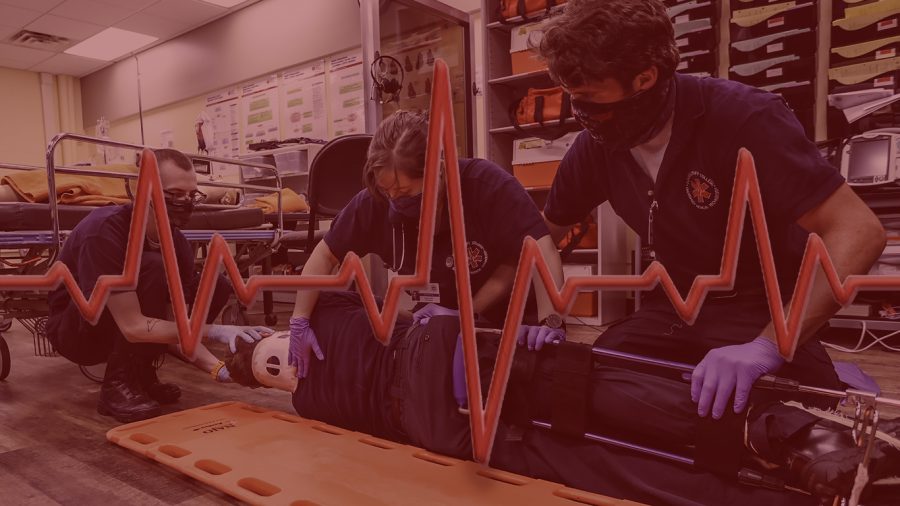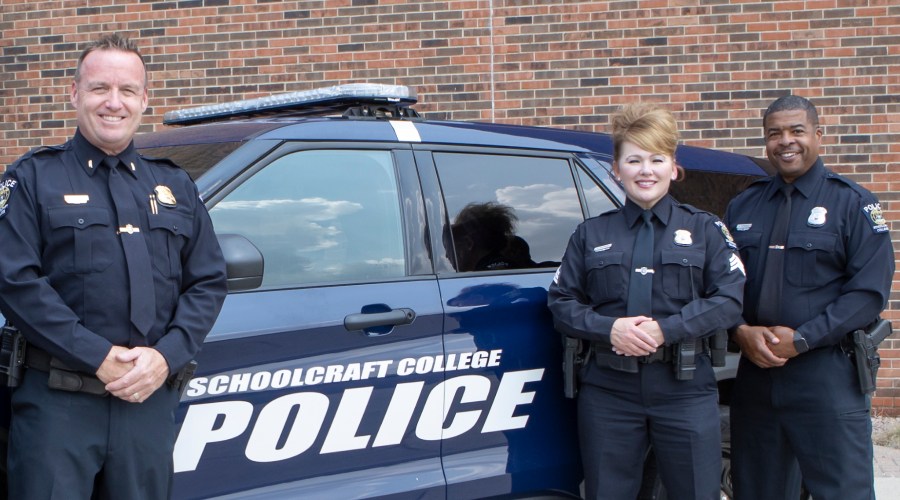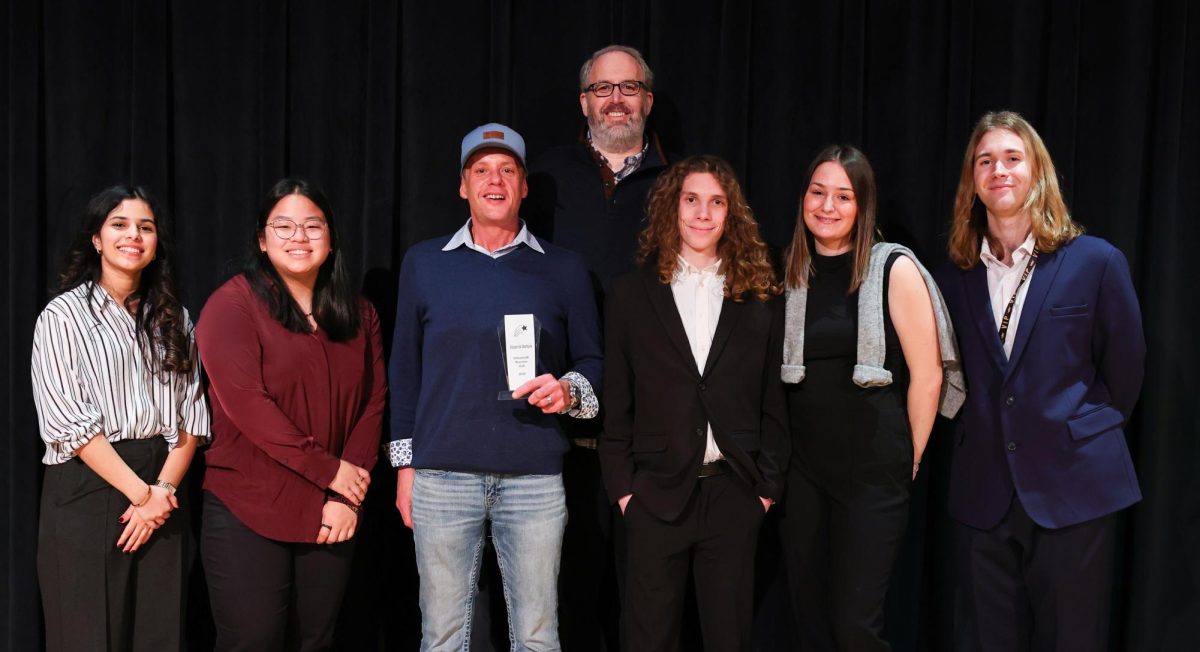Never skipping a beat
Emergency Medical Technology program perseveres despite COVID-19 complications
Students in the Emergency Technology Program work on backboarding a patient during a class exercise.
January 21, 2021
In a medical crisis, it is the emergency medical technicians (EMTs) and paramedics that provide front-line emergency lifesaving services to those in need. At Schoolcraft, the philosophy of putting others first and persevering through immense hardship is ingrained into every aspiring students’ mind. This is precisely why our EMT program strives to continue training the next generation and preparing to continue serving the community as COVID-19 persists in the community.
Responding to the pandemic
“From the beginning, we have strived to continue educating and preparing our students for the field. The first question we had to answer was how to proceed with the semester that was cut short when the virus first broke out,” states Thomas Worthington, who serves as the program’s coordinator. “During that time and even now, we are maintaining an online presence that supports live lectures and discussion. Practical skill training through the lab and clinical setting is still taking place in a limited capacity, but with appropriate precautions such consistent screening, donning a mask and maintaining social distance as much as possible.”
As program coordinator, Worthington manages various responsibilities and obligations. These include teaching, conversing with clinical partners and assisting in the maintenance of the program’s accreditation so that students are approved to take the national licensure examination to become emergency technicians and paramedics. In addition to these tasks, Worthington also handles a lesser-known process that is incredibly vital to our campus: Training and continued education for campus police.
“We do what needs to be done for any situation, including this pandemic, and aim to be prepared to the best capacity possible,” Worthington commented. “Our students worked diligently to meet the requirements to be admitted into this program. Upon graduation, our alumni are highly sought after and there’s no concern of harm coming to patients treated by them.”
The Emergency Medical Technology program’s influence reaches far within and beyond our campus, especially now the public is in a state of crisis with COVID-19 surging. Worthington, colleagues, and students all had to adjust, prepare, continue upholding their purpose and leading the community through such unprecedented times. When the pandemic was declared, he had to act fast and make difficult decisions like so many of our frontline workers in the field. For example, classes were extended by 8-9 weeks. This meant conducting a hybrid format through the summer and fall with practical skill instruction being done through Zoom. It was June before faculty and students were able to return for in-person instruction in the lab and clinical setting, but even then, it was limited to 6 to 8 students per social distancing guidelines and COVID-19 surely was not going to impede upon their mission.
Start your career here
According to Worthington, the Emergency Medical Technology program is an excellent choice for students looking to secure a job upon graduation within a lucrative health system and to obtain a training credential with the potential of continuing within the field. The first step, which is highly recommended, is for potential applicants to discuss their intention and formulate a course plan prior to applying. This is important because students must meet the appropriate requirements for acceptance into the EMT program first before they may pursue additional training to become a paramedic, including the proper certification obtained from passing the state licensure exam.
“For the simplicity of discussing both programs, students must be 18 years old upon application to be eligible for state licensing. They must also have a clean criminal background that is free of serious charges. It’s also required to pass Biology 101 with a 2.0 and 236 with a 3.0,” Worthington explained.
Among these admission requirements are a list of technical skills and course competencies that students must master while in the program. These include reading and speaking articulately, being capable of manual mathematics and being able to work in a stressful environment. Most importantly, EMTs and paramedics are to be trained in oxygen support, intubation, cardiac monitoring, blood control and trauma support for both children and adult patients.
Many programs require that students obtain their Basic Life Support (BLS) and Advanced Cardiac Life Support (ACLS) certifications, similar as to our college, but Schoolcraft is unique in the fact that it is the only program where trauma support is included in program training.
“This is an important differentiation among other colleges and universities compared to us. It’s also why our alumni are so sought after upon licensure and graduation,” Worthington remarked.
Course selection for both programs is limited to the fall and winter semesters with few exceptions. For instance, the paramedic program is only available during the day in fall and winter seasons while EMT is offered every semester with options for day or night during the fall, but only daytime during the spring and summer terms.
“All courses are to be taken in sequence,” Worthington said. “It’s important that we avoid any gaps in students’ knowledge and continue upholding our standard both on and off the campus.”
Inside perspective
One cannot quite imagine or assume an experience without an account from someone who has lived through it though. Jared Vandeguchte, a twenty-year-old student and aspiring firefighter, gave the following insight:
“This program can be incredibly stressful and requires a lot of sacrifice but is overall extremely rewarding for people like me that want to help people and make a difference. There’s so much real word experience provided to assist in learning skills, including clinical and ride alongs through fire departments and private companies. Even with the pandemic, the level of education is fantastic, and the precautions are top notch as we are screened on lab days, taught preventive measures to use in the field when around suspected or confirmed patients. Since we are exposed to so many people, we’re at higher risk for contamination. On campus classes are cancelled if students get sick to protect everyone, but for the most part, I want to move forward come hell or high water so I can help people in the field.”
For more information about the program, please contact program director, Thomas Worthington at [email protected] or 734-462-4786.
More information can also be found at schoolcraft.edu/academics/2020-2021/healthcare-and-health-sciences/emergency-medical-technology/emt-paramedic-aas-degree.









